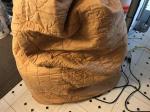This was written after using the product for abt a week. If anything changes I’ll make an update.—-REVIEW—-I’m a beekeeper and harvest honey in our small boutique mountain honey operation. Last year family emergencies precluded me from processing the last pull of abt 55gals of honey. I typically extract & store them in 5gal buckets to await processing into creamed honey.Winter and cold temps set in early and by the time I was ready to process the honey into creamed, it had all crystallized….SOLID!Instead of heating our extraction house, hot enough to melt the crystals (crystals begin to melt@95°-104°) and spending a fortune in heating and working in sweltering heat, I ordered a bunch of these blankets because 122° (the limit of these blankets) is perfect to melt honey and not pasteurize it (above 160°) as in our State anything over 160° and we can’t label it RAW Honey.Also anything over 140° will melt beeswax and put micro wax in your honey.It took 72 hours to liquify each bucket (stirring on the 2nd & 3rd mornings).The honey heating blankets lose a lot of heat to the outside and so to improve their efficiency I wrapped 3 buckets together with first bubble wrap, then a blanket (see photos). That keeps most of the heat on the buckets and I’m sure the thermostats don’t have to turn on so often.Checking their final honey temps at the end of 72hrs the range was from 117° to 125°.These will also come in handy to heat our extractors so our extremely thick honey will flow easier on cooler days and we won’t have to heat out extraction house to 90°HOBBISTSIf you’re a hobby beekeeper, you can use these to heat a bucket of capping wax and junk honey scrapings and the honey will easily separate from the wax and you’ll have pure honey on the bottom of the bucket and wax in the top. This will allow you to be like the big commercial operations with large heated separation tanks. These honey heating blankets do not get hot enough to melt the wax so you won't have noticeable



